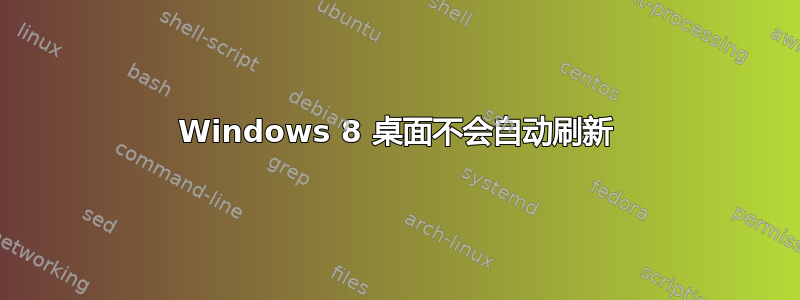
我刚刚遇到了桌面无法自动刷新的问题。我试过重启电脑,但没用。
问题是,每当我删除、移动、复制文件或执行任何其他应该导致桌面刷新的操作时,它都不会刷新。我必须自己刷新它,然后才能看到更改。
我怎么解决这个问题?
答案1
听说过 Win7 存在这个问题,重建图标缓存可以解决这个问题..所以可能想尝试一下...
下面是我找到的适用于 win7 的脚本:
@echo off
cls
echo The Explorer process must be killed to delete the Icon DB.
echo Please SAVE ALL OPEN WORK before continuing
pause
taskkill /IM explorer.exe /F
echo Attempting to delete Icon DB...
If exist %userprofile%\AppData\Local\IconCache.db goto delID
echo Previous Icon DB not found...trying to build a new one
goto :main
:delID
cd /d %userprofile%\AppData\Local
del IconCache.db /a
pause
echo Icon DB has been successfully deleted
goto main
:main
echo Windows 7 must be restarted to rebuild the Icon DB.
echo Restart now? (Y/N):
set /p choice=
If %choice% == y goto end
echo Restart aborted...please close this window
explorer.exe
:end
shutdown /r /t 0
exit
这是我在这里找到的可能的解决方案的列表:http://www.pcadvisor.co.uk/news/software/3346081/what-do-when-windows-explorer-doesnt-refresh/
1. Registry Changes
One of the most successful solutions to this problems (although it doesn't help all the time) is to turn on the Windows desktop refresh feature. To do this, go to "HKEY_CLASSES_ROOT\CLSID\{BDEADE7F-C265-11D0-BCED-00A0C90AB50F}\Instance", look out for a DWORD value called "DontRefresh" which is set to "1" (on). Change the value to "0" (off). This re-enables the refresh. Note that the CLSID given above may depend on your machine. The easiest solution if you can't find the key is to just go to "HKEY_CLASSES_ROOT\CLSID", hit "F3" and do a search for "DontRefresh".
2. Sort by Name
Many users have had success by simply sorting both their desktop and explorer folders "By Name". This suggests to me that the Windows Search API has something to do with the problem.
Obviously this is more of a workaround than a solution and just isn't an alternative for some people.
3. Re-enable User Account Control
One of the first steps I take whenever I install Windows 7 is to turn off User Account Control (UAC). Well, according to this Microsoft KB article that's the culprit of my random refresh problem. If you'd rather live with a few clicks on the "Continue" button than with the annoying refresh bug, I suggest you turn UAC back on again: Open up the Start menu, type in "User Account Control" and hit "Enter". Then, switch back to the default setting "Notify me only when apps try to make changes to my computer":
4. Turn off Third-Party Shell Extensions
It turns out that quite a lot of third-party applications hook themselves into Windows Explorer. If file management goes awry (which it certainly has in our example), it's always wise to check which of these explorer hooks are being loaded and turn them off temporarily: The most reliable tool that helps you check for solutions is Nirsoft's "ShellExView". Download it, install it and sort by "Company". This will show all third-party hooks at the top of the list:
Try disabling ALL of them to see if that solves the problem. If it did, re-enable these hooks one by one.
Reboot the PC and see if the problem rears its ugly head again.
5. Try a Different Firewall/AV solution
Security suites obviously watch for file system activities. Their filter drivers may be a cause for file operations completing but not registering them with the UI. If none of the previous solutions worked, you might as well try a different security suite for a couple of days. Alternatively, you can try to switch to a less tight security setting and observe Explorer operation behavior.
6. Turn off Sharing
I have noticed that this bug appears on shared folders more often than on regular folders. For example, I share my "Pictures" library on my home network and this is one of the places where I see the refresh bug more often.
If you're not sharing media, make sure that Windows Media Player network sharing is turned off. You'll find the OFF switch under "Control Panel\Network and Sharing Center\Change advanced sharing settings".
7. Rebuild the Explorer Icon Cache
The icon cache in Windows Vista, 7 and 8 stores thumbnails of files -- if this cache has somehow reached its limit or got corrupted, you might need to rebuild it from scratch. Here's how: Close all programs and Windows and run "Task-Manager" by using the CTRL + SHIFT + ESC key combo. Kill "Explorer.exe". Go to "File/Run New Task" and type in "cmd". Enter the following commands and hit Return after each one:
CD /d %userprofile%\AppData\Local
DEL IconCache.db /a
EXIT
8. Turn off NTFS Last Access File Stamp
The NTFS file system updates the "last access" timestamp whenever a file is opened. This time stamp did, on some user machines, cause new or changed files to not appear until an Explorer refresh. Try turning the Last Access stamp off: Open up the registry and go to "HKEY_LOCAL_MACHINE\SYSTEM\CurrentControlSet\Control\FileSystem". Double-click on "NtfsDisableLastAccessUpdate" and set the value from "1" to "0". Now reboot.
Note: Some (rare) applications may depend on the NTFS stamp -- make sure that all your apps are still working.
9. Uncheck "Show Hidden Files and Folders"
Some users on the MS TechNet forums also claim to have solved the problem by unchecking the "Show Hidden Files and Folders" box in Windows Explorer properties.
10. Turn off Home Groups
Is the Home Group feature enabled on your system? If so, try turning Home Groups off -- including all the services that come with it. Fire up "services.msc" and disable both the "HomeGroup Listener" and the "HomeGroup" provider service. Again, a sharing related feature seems to be one of the many causes for this issue.
11. Restore the Explorer Settings
Some users seem to have had success after resetting the Explorer settings: Go to the "Folder Options" dialog and hit "Restore Defaults" -- et voilà.


